Life goes on in Back Swamp
COVID-19 is wreaking havoc all over the world, but life goes on like clockwork in our little corner of the world.
I’ve been working from home since Tuesday, March 17. Clemson University required all faculty and staff to perform non-essential tasks remotely starting on Monday, March 16. But, I was already on the road visiting a couple of growers when I received the directive, so my home office didn't become operational until Tuesday.
Since I can work entirely from home, I’m starting to wonder: Perhaps all I do is “non-essential?”
The mole-huntress is happy that I’m home. She was elated when multiple medical experts debunked publicly recent reports that dogs can contract from, and transmit coronavirus to, humans. Lifting her dirt-covered muzzle, she tells the world, “Hug me!”
So, life (and its associated bugs and cruds) goes on.
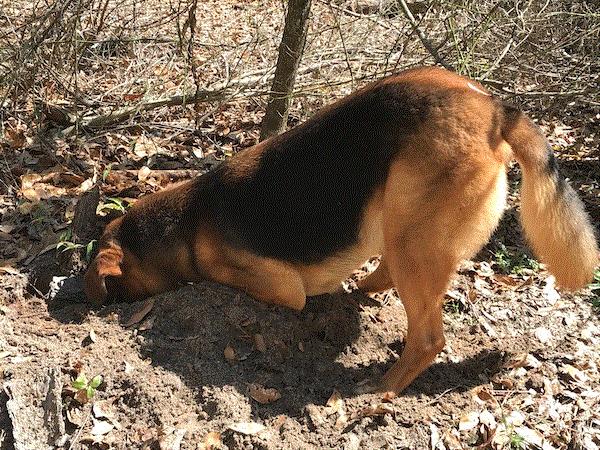
Gosh! It's ambrosia beetle season again?
I’ll be working on several ambrosia beetle projects this spring. Angel Acebes at the University of Georgia was brave enough to herd us entomological cats, and started an ambrosia beetle monitoring network. We’ll be setting up ethanol-baited soda bottle traps and bolt traps from New York to Georgia. The idea is to develop an alert or warning system (to be housed at the Southern Region IPM Center) for growers of ornamental, fruit and nut trees for when ambrosia beetles are flying (using soda bottle traps) and attacking trees (confirmed with bolt traps). We expect to see a nice wave of alerts light up as temperatures rise from the South to the North. We are gathering the preliminary data this spring, and will use the data to ground-truth the network before it goes public.
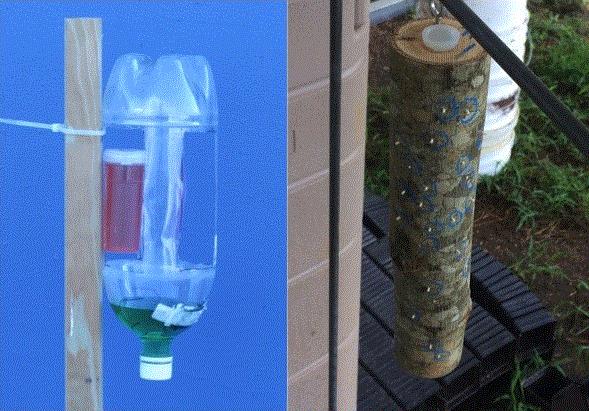
A soda bottle trap with ethanol lure (left; photo credit: JC Chong) and an ethanol-filled bolt trap (right; photo credit: Matthew Brown, Tennessee State University).
The southern most location of this monitoring network is Tifton, Georgia, where Angel is located. Her bolt traps were attacked during a warm spell in mid-February. I had attacks on my bolt traps last week. If the warm spell continues, we may have an early ambrosia beetle season this year.
If you battle ambrosia beetles frequently, this is the time to set up your own soda bottle and bolt traps. Start your treatment as soon as beetles are collected in the soda bottle traps. If you want even more precise timing so you don't waste your insecticides and labor, then spray when the bolt traps are being attacked.
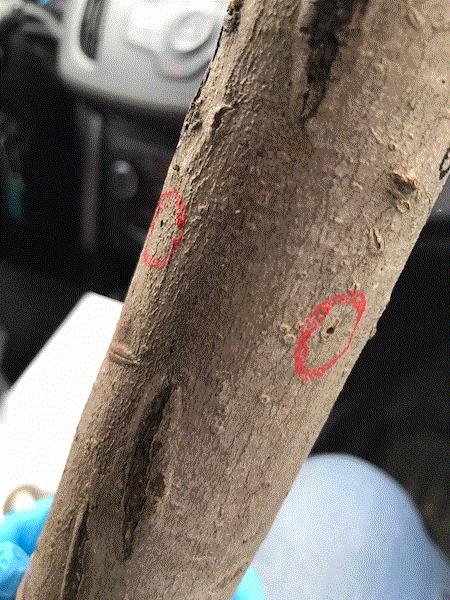
A red maple bolt with ambrosia beetle entry holes circled in red. (Photo credit: Shawn Chandler, Clemson University)
The most effective products are bifenthrin and permethrin. In my experience, one application of these pyrethroids to the trunks provides seven to ten days of residual protection under typical weather conditions. Most growers will have to spray weekly or biweekly to achieve good prevention of attacks. Spray programs stop after the canopy flushes out.

Mysterious Dahoon holly woe from last week
I asked for help in the last issue of this newsletter in identifying the cause of distorted new growth on Dahoon holly.
Many of you responded! Thanks to Aaron Palmateer, Albert Van Hoogmoeg, Carol Harlos, Heather Augustine, Tom Ericson and Victor Hlavacek for giving me ideas and advice.
The one who came the closest was Aaron Palmateer. Aaron was an ornamental plant pathologist at the University of Florida; he is now the Senior Technical Service Representative at Bayer.
Aaron’s diagnosis was sphaeropsis tip blight, and I pooh-poohed his idea at first. Diagnosis report indicated several cultural and environmental problems that can lead to the symptoms of yellowed or chlorotic foliage. One died-back branch yielded cultures of botryosphaeria fungus (species not determined). One species, Botryosphaeria dothidea, is responsible for cankers on over one hundred woody plant genera. The family Botryosphaeriaceae includes some familiar fungal diseases—diplodia and sphaeropsis cankers and tip blights—and its taxonomy is a mess. I tried to read through some papers on this topic, but quickly realized that I might as well be reading Sumerian. These exercises once again proved the point of not sending an entomologist to do a pathologist’s job (and vice versa).
So, Aaron (I know you are reading this), I owe you an apology and a beer! Claim both at Cultivate if we don't see each other soon.
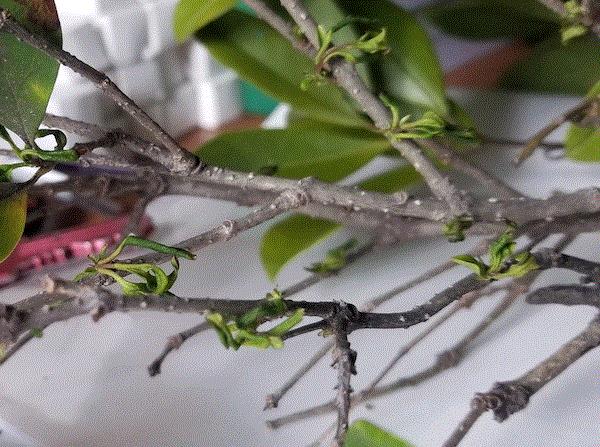
What's causing the wilted growth? (Photo credit: Vicky Bertagnolli, Clemson University Extension Service)
It’s important to note that finding fungus on one branch doesn't mean we have solved the mystery. Healthy plants are rarely susceptible to botryosphaeria canker. So, some kind of environmental stress (such as heat, drought and low temperatures) and injuries (such as from mechanical, pruning or hedging damage) can predispose a plant to attacks.
The first step in management is to correct these stresses. The diseased tissues also should be pruned and properly disposed of. Fungicides are generally ineffective in protecting the plants from botryosphaeria canker. But, if you feel spraying makes you feel better, some of the more effective products include QoI fungicides (such as azoxystrobin, pyraclostrobin and trifloxystrobin) and carboxamides.
Leprotec receives California registration
Vestaron Corp. announced this week that Leprotec has received registration approval in California. With that, Leprotec is now registered in all fifty states.
Leprotec is a liquid formulation of the bacterium Bacillus thuringiensis subspecies kurstaki strain EVB-113-19. It’s registered for controlling various caterpillar species in fruit, nut, vegetable, herb, agronomic and ornamental crops, and lawns. Ornamental use sites for ornamental crops include greenhouse, outdoor nursery and landscape plantings. PPE includes long-sleeved shirt, long pants, waterproof gloves, shoes, socks and protective eyewear. REI is four hours. Leprotec is OMRI-listed.
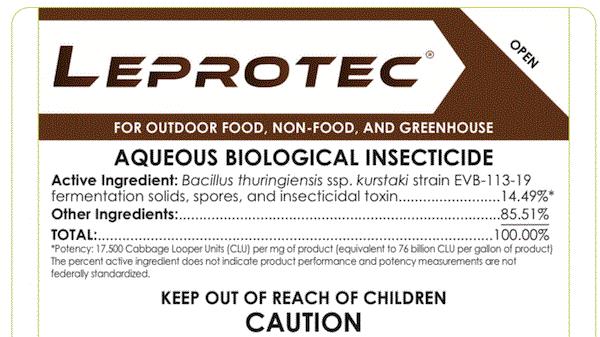
When Leprotec is sprayed, the bacterial spores are deposited in a thin layer on the foliage, which are then ingested as the caterpillars feed on the foliage. Once inside the midgut, the spores germinate and produce a toxin that attaches to the gut cell membrane and makes the membrane porous. In another word, the Bt toxin rots the caterpillars’ guts out. The caterpillars then starve and die. Colonization by the bacteria can also cause death.
One note about using any Bt product: Efficacy is greater when the products are used against younger larvae. When dealing with larger larvae, a higher application rate of Bt products may have to be used but with marginal efficacy. A better solution may be using other insecticides.
Vestaron recommends combining Leprotec with its Spear-Lep bioinsecticide for greater efficacy.
For more information on Leprotec, click here.

Greenhouse Training Online is back!
Has your boss, like mine, told you to stay home? Are you dying to do something? Here is an educational opportunity.
University of Florida’s Greenhouse Training Online Course is back. The first course, Greenhouse 101, will start on June 1. Since all courses are done online, you don't have to step outside of your door.
There is a total of six courses you can take from June 1 to December 11: Greenhouse 101, Nutrient Management, Advanced Nutrient Management, Disease Management, Weed Management and (new this year) Hydroponic Vegetable Production. You can take all six courses, or any one of them.
Click here for more information on the online courses.
Enjoy time amidst uncertainties
I’ll close this issue of PestTalks by showing you a person wiped out during an overnight mountain biking trip the weekend before last. I was one of the two people in the picture—guess which one.

Really, the wipeout was real! Fortunately, there were no injuries because I bailed just in time. (I kept a promise to my wife and kept my noggin intact.) I couldn't fool my wife because the act was up as soon as she saw Vincent’s face. Darn it! Vincent better keep his day job as an engineer.
Go enjoy the sun and stay sane!

JC Chong
Professor of Entomology at Clemson University
This e-mail received by 22,737 subscribers like you!
If you're interested in advertising on PestTalks contact Kim Brown ASAP!